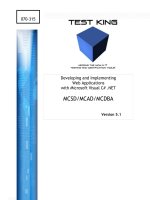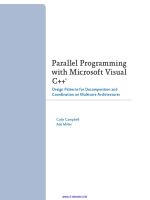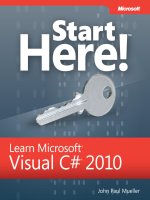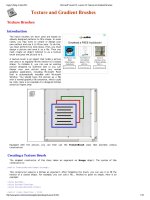Sams microsoft visual c sharp 2005 unleashed may 2006 ISBN 0672327767
Bạn đang xem bản rút gọn của tài liệu. Xem và tải ngay bản đầy đủ của tài liệu tại đây (1 MB, 1,112 trang )
Microsoft®VisualC#2005Unleashed
ByKevinHoffman
...............................................
Publisher:Sams
PubDate:May09,2006
PrintISBN-10:0-672-32776-7
PrintISBN-13:978-0-672-32776-6
Pages:720
TableofContents|Index
SettingthestandardforapremiumC#reference,MicrosoftVisualC#2005Unleashed
providespracticalexamplesforvirtuallyeveryaspectoftheC#programminglanguage.
Thebookisstructuredforprogressivelearning,soitcanbereadcover-to-coverorusedas
acomprehensivereferenceguide.Youwillbeexposedtoeverythingfromlow-level
informationontheGarbageCollectortoadvancedconcepts,suchascreatingapplications
thatuseEnterpriseServices,creatingWebServices,andevenadvancedWindowsGUI.
Chaptersinclude:
ExpressionsandControlStructures
UIControls
CodeAccessSecurity
Remoting
Peer-to-PeerApplications
Microsoft®VisualC#2005Unleashed
ByKevinHoffman
...............................................
Publisher:Sams
PubDate:May09,2006
PrintISBN-10:0-672-32776-7
PrintISBN-13:978-0-672-32776-6
Pages:720
TableofContents|Index
Copyright
AbouttheAuthor
WeWanttoHearfromYou!
ReaderServices
Introduction
PartI:C#2.0Fundamentals
Chapter1.IntroductiontoC#2.0
WhatIsthe.NETFramework?
WorkingwithVariablesinC#2.0
C#BasicSyntax
WhatYouCanDowithC#
Summary
Chapter2.ExpressionsandControlStructures
BranchingandConditionalLogic
LoopingandRepetition
Summary
Chapter3.StringsandRegularExpressions
WorkingwithStrings
WorkingwithRegularExpressions
Summary
Chapter4.ArraysandCollections
WorkingwithArrays
WorkingwithCollections
Summary
Chapter5.Object-OrientedProgramminginC#
Object-OrientedDesign
Object-OrientedProgramming
Summary
Chapter6.IntroductiontoGenerics
OverviewofGenerics
BuildingGenericTypes
UsingGenericCollections
Summary
PartII:.NETFramework2.0Fundamentals
Chapter7.I/OandPersistence
IntroductiontoStreams
IntroductiontoBasicFileI/O
UsingAsynchronousFileI/O
WorkingwithIsolatedStorage
Summary
Chapter8.WorkingwithXML
ReadingandWritingXMLDocuments
QueryingXMLwithXPath
TransformingDocumentswithXSLT
ValidatingDocumentswithXSD
Summary
Chapter9.EventsandDelegates
IntroductiontoDelegates
UsingAnonymousMethods
CreatingMulticastDelegates
IntroductiontoEvents
AdvancedEvent-BasedProgramming
Summary
Chapter10.MultithreadedProgramming
TheBasicsofThreadedProgramming
WritingYourFirstMultithreadedApplication
DealingwithThreadSynchronizationandContention
UsingtheThreadPoolClass
Summary
Chapter11.ReflectionFundamentals
IntroductiontoReflection
WorkingwithMethodInformation
WorkingwithMemberInformation
ExaminingEvents
CreatingandExaminingCustomCodeAttributes
Summary
Chapter12.AssembliesandAppDomains
IntroductiontoAssemblies
AssembliesUndertheHood
BuildingandUsingAssemblies
StoringandRetrievingAssemblyResources
LocalizationandSatelliteAssemblies
IntroductiontoAppDomains
ProgrammingwithAppDomains
Summary
Chapter13.COMandWindowsInteroperability
IntroductiontoInteroperabilityinC#
UsingCOMObjectsfromthe.NETFramework
Using.NETClassesfromCOM
AccessingCodeinUnmanagedDLLs
Summary
Chapter14.CodeAccessSecurity
IntroductiontoCodeAccessSecurity(CAS)
UsingandAdministeringSecurityPolicy
UsingImperativeSecurity
UsingDeclarativeSecurity
Summary
Chapter15.CryptographyandDataProtection
IntroductiontoCryptography
UsingSecret-KeyEncryption
UsingPublic-KeyEncryption
WorkingwithHashesandDigitalSignatures
UsingtheDataProtectionAPI(DPAPI)
Summary
Chapter16.OptimizingYour.NET2.0Code
UnderstandingBoxingandUnboxing
UsingProperStringManipulationTechniques
EfficientLoopConstruction
SpeedingUpApplicationStartTimes
CodeProfilingUsingthePerformanceWizard
Summary
PartIII:DataAccesswith.NET2.0
Chapter17.ADO.NETFundamentals
IntroductiontoADO.NET
EstablishingaConnection
CommunicatingwiththeDataSource
WorkingwiththeData
Summary
Chapter18.AdvancedADO.NETTechniques
WorkingwiththeNewImprovedDataTable
AccessingDataAsynchronously
UpdatingDatainBatches
UsingtheNewSystem.TransactionsNamespace
Summary
Chapter19.WorkingwithADO.NETDataProviders
IntroductiontoADO.NETDataProviders
UsingProviderFactories
WorkingwithConnectionStrings
EnumeratingDataSources
ObtainingAdditionalProviderInformation
CreatingaCustomADO.NETDataProvider
Summary
Chapter20.StronglyTypedDataSets
IntroductiontotheTypedDataSet
ConnectingTypedDataSetstoLiveData
AnnotatingaTypedDataSet
ExtendingaTypedDataSetUsingPartialClasses
Summary
Chapter21.ProgrammingwithSQLServer2005
IntroductiontotheSQLServer2005CLRHost
BuildingC#StoredProcedures
BuildingC#User-DefinedFunctions
CreatingaC#User-DefinedType
WorkingwiththeNewServer-SideSQLLibrary
UsingMARS(MultipleActiveRecordSets)
Summary
PartIV:DevelopingASP.NET2.0WebApplications
Chapter22.IntroductiontoASP.NET2.0andWebForms
IntroductiontoASP.NET2.0
UnderstandingtheASP.NETPageLifeCycle
OverviewofControlsProvidedbyASP.NET
CreatingandDebuggingASP.NETApplications
HandlingEventsandPostbacks
BuildingInteractiveDynamicPagesUsingClientCallbacks
Summary
Chapter23.StateManagementinASP.NET2.0
WorkingwithApplicationState
WorkingwithSessionState
WorkingwithViewState
StateManagementinWebFarms
Summary
Chapter24.UsingMasterPages
TheWorldBeforeMasterPages
IntroductiontoMasterPages
AdvancedMasterPagesTechniques
Summary
Chapter25.ASP.NETPersonalizationandCustomization
UserInterfaceTailoringwithThemesandSkins
WorkingwithASP.NETUserProfiles
UserCustomizationwithThemesandProfiles
Summary
Chapter26.IntroductiontoWebParts
WebPartBasics
UsingaPersonalizationProvider
BuildingYourFirstWebPartPage
CreatingWebParts
BuildingConnectedWebParts
Summary
Chapter27.BuildingRich,Data-DrivenWebApplications
IntroductiontoDataBindinginASP.NET
UsingData-BoundControls
AdvancedData-BindingTechniques
Summary
Chapter28.SecuringYourASP.NETApplications
SecurityThroughAuthentication
SecurityThroughAuthorization
TheASP.NETSecurityControls
AdvancedASP.NETSecurity
Summary
Chapter29.CreatingCustomASP.NETProviders
TheMembershipProvider
TheRoleProvider
TheProfileProvider
AdditionalProviders
Summary
Chapter30.DevelopingASP.NETControls
BuildingUserControls
CreatingServerControls
ManagingStateWithinServerControls
Summary
Chapter31.ASP.NETManagementandMonitoring
IntroducingtheNewHealthMonitoringSystem
UsingASP.NETPerformanceCounters
Summary
PartV:WebServices
Chapter32.ExposingFunctionalitywithWebServices
IntroductiontoWebServices
CreatingaSimple"HelloWorld"Service
CreatingTransactionalServices
ManagingStateinWebServices
Summary
Chapter33.AdvancedWebServicesProgramming
DesigningforService-OrientedArchitectures(SOA)
UsingWebServiceDiscovery
UsingCustomSOAPHeaders
ProgrammingSecureWebServices
Data-BindingWindowsFormstoWebServices
Summary
PartVI:DevelopingWindowsForms2.0Applications
Chapter34.IntroductiontoWindowsForms2.0
WindowsFormsBasics
CreatingaWindowsFormsApplication
UsingtheWindowsFormsDesigner
ElementsofGoodUserInterfaceDesign
Summary
Chapter35.TheWindowsFormsControlLibrary
TheCommonControlsToolbox
Containers
MenusandToolbars
TheData-RelatedControls
TheComponentsToolboxGroup
ComponentsandControlsforPrinting
DialogComponents
Summary
Chapter36.AdvancedUserInterfaceProgramming
IntroductiontoGDI+
CreatingShapedFormsandControls
UsingVisualInheritance
GlobalizingYourUserInterface
Summary
Chapter37.DataBindingwithWindowsForms2.0
BindingwithTypedDataSets
IntroducingtheBindingSource
UsingtheBindingNavigator
WorkingwiththeDataGridView
DataBindingwithObjects
Parent-DetailBinding
Summary
Chapter38.DevelopingSmartClients
PracticalWebServiceConsumption
UsingtheNewApplicationSettingsSystem
SupportingOfflineandOnlineOperation
AuthorizingandAuthenticatingUsers
MultithreadedWebServiceConsumption
UsingtheBackgroundWorkerControl
Summary
Chapter39.DeployingApplicationsUsingClickOnce
IntroductiontoClickOnce
PublishingClickOnceApplications
UpdatingClickOnceApplications
ProgrammingwiththeSystem.Deployment.ApplicationNamespace
Summary
Chapter40.UsingEnterpriseServices
RegisteringServicedComponents
Just-in-TimeActivationandPooling
QueuedComponents
Role-BasedSecurity
Transactions
SharedProperties
LooselyCoupledEvents
Summary
PartVII:DevelopingEnterpriseandDistributedApplications
Chapter41.Remoting
OverviewofRemoting
WorkingwithRemotingChannels
WorkingwithLifetimeLeases
RemotingwithGenerics
Summary
Index
Copyright
Microsoft®VisualC#2005Unleashed
Copyright©2006bySamsPublishing
Allrightsreserved.Nopartofthisbookshallbereproduced,
storedinaretrievalsystem,ortransmittedbyanymeans,
electronic,mechanical,photocopying,recording,orotherwise,
withoutwrittenpermissionfromthepublisher.Nopatent
liabilityisassumedwithrespecttotheuseoftheinformation
containedherein.Althougheveryprecautionhasbeentakenin
thepreparationofthisbook,thepublisherandauthorassume
noresponsibilityforerrorsoromissions.Norisanyliability
assumedfordamagesresultingfromtheuseoftheinformation
containedherein.
LibraryofCongressCatalogCardNumber:2006901231
PrintedintheUnitedStatesofAmerica
FirstPrinting:May2006
090807064321
Trademarks
Alltermsmentionedinthisbookthatareknowntobe
trademarksorservicemarkshavebeenappropriately
capitalized.SamsPublishingcannotattesttotheaccuracyof
thisinformation.Useofaterminthisbookshouldnotbe
regardedasaffectingthevalidityofanytrademarkorservice
mark.
MicrosoftisaregisteredtrademarkofMicrosoftCorporation.
WarningandDisclaimer
Everyefforthasbeenmadetomakethisbookascompleteand
asaccurateaspossible,butnowarrantyorfitnessisimplied.
Theinformationprovidedisonan"asis"basis.Theauthorand
thepublishershallhaveneitherliabilitynorresponsibilitytoany
personorentitywithrespecttoanylossordamagesarising
fromtheinformationcontainedinthisbook.
BulkSales
SamsPublishingoffersexcellentdiscountsonthisbookwhen
orderedinquantityforbulkpurchasesorspecialsales.For
moreinformation,pleasecontact
U.S.CorporateandGovernmentSales
1-800-382-3419
ForsalesoutsidetheUnitedStates,pleasecontact
InternationalSales
Publisher
PaulBoger
AcquisitionsEditor
NeilRowe
DevelopmentEditor
MarkRenfrow
ProjectEditor
TonyaSimpson
CopyEditor
MargaretBerson
Indexer
KenJohnson
Proofreader
SusanEldridge
TechnicalEditor
J.BoydNolan
PublishingCoordinator
CindyTeeters
InteriorDesigner
GaryAdair
CoverDesigner
AlanClements
Dedication
Writingatechnicalbookinvolvesjustasmuchcreativityand
inspirationaswritingafantasyorasciencefictionnovel;it's
justadifferentkindofinspiration.Iwouldliketodedicatethis
booktomyinspiration:mywonderfulwife,Connie.
Regardlessofwheretheinspirationcomesfromorwhatit
produces,it'sstillahighlycreativeprocessthatissubjectto
writer'sblockandfitsofirritability,crankiness,defeatism,and
beingsoabsorbedinaparticulartopicthattheworldaround
meceasestoexistuntilIhaveconqueredthattopic.
Ittrulyisabattle,"mevs.thetechnology."Theproblemisthat
thisbattlerequiresahugetimeinvestment.Somehowmywife
hasmanagedtotoleratemebeinginthesameroombutsimply
"notbeingthere"whileItypeawayinordertodefeatthe
chaptersthatloombeforeme,daringmetotakethemon.My
daughter,Jerrah,hasherownkeyboardsothatshecan
pretendto"bebusy"justlikeDaddy.There'ssomething
bittersweetaboutthefactthatshewantstobelikeme,butthat
herimpressionofmeisoneofbeingbusyandtypingallthe
time.
Mywife'spatience,love,caring,andsupporthavebeen
invaluable.Withouthersupport,Iwould'vegivenuponwriting
beforeIevengotstarted.AndcertainlywithoutherInever
wouldhavebeenabletowritethisbook,thesinglelargestand
mosttime-consumingbookI'veeverwritten.
Regardlessofwhichdeityyoubelievein,orwhetheryoubelieve
inone,youmustconcedetheexistenceofangels.Afterall,I
ammarriedtoone.
AbouttheAuthor
KevinHoffmanhasbeenprogrammingformorethan20
years.Hegotstartedwhenhisgrandfatherrepairedadiscarded
CommodoreVIC-20andhegotrighttoworkcreatingtextbasedrole-playinggamesinBASIC.Sincethen,hehas
dedicatedhimselftolearningallthereistoknowabout
programming,andusingeveryprogramminglanguagehecould
find,includingPascal,C,C++,Scheme,LISP,ADA,Perl,
Python,Java,andmanyothers.Whenhefirstsawapre-beta
releaseofC#1.0,hewashooked.Heknewatthatmoment
thatthe.NETFrameworkwouldrevolutionizehowdevelopers
createdsoftwareandhowpeopledesignedsoftware,andwould
enablenewtypesofapplicationsandnewfunctionalitythat
eitherusedtobeimpossibleortoocost-prohibitivetoeven
attempt.Asaresultofhispassionforthe.NETFramework,he
hasdubbedhimselfthe".NETAddict."
WeWanttoHearfromYou!
Asthereaderofthisbook,youareourmostimportantcritic
andcommentator.Wevalueyouropinionandwanttoknow
whatwe'redoingright,whatwecoulddobetter,whatareas
you'dliketoseeuspublishin,andanyotherwordsofwisdom
you'rewillingtopassourway.
AsapublisherforSamsPublishing,Iwelcomeyourcomments.
Youcanemailorwritemedirectlytoletmeknowwhatyoudid
ordidn'tlikeaboutthisbookaswellaswhatwecandotomake
ourbooksbetter.
PleasenotethatIcannothelpyouwithtechnicalproblems
relatedtothetopicofthisbook.WedohaveaUserServices
group,however,whereIwillforwardspecifictechnical
questionsrelatedtothebook.
Whenyouwrite,pleasebesuretoincludethisbook'stitleand
authoraswellasyourname,emailaddress,andphonenumber.
Iwillcarefullyreviewyourcommentsandsharethemwiththe
authorandeditorswhoworkedonthebook.
Email:
Mail:
PaulBoger
Publisher
SamsPublishing
800East96thStreet
Indianapolis,IN46240USA
ReaderServices
Visitourwebsiteandregisterthisbookat
www.samspublishing.com/registerforconvenientaccesstoany
updates,downloads,orerratathatmightbeavailableforthis
book.
Introduction
Ifyoucanforceyourselftothinkback10years,thinkaboutthe
proliferationoftechnologyinjustthatshortperiodoftime.
Backinthe"goodole"days,youcouldwalkdownabusycity
street,andyouprobablywouldn'tseeanyonetalkingonacell
phone.Youwouldn'tseepeoplebusilytappingattheirPDAs.
Youdefinitelydidn'tseeanyonesittinginanInternetcaféusing
aTabletPCtosendhand-sketchedapplicationdesignshalfway
aroundtheworldtoaremotedevelopmentteam.
Connectivitybetweenapplicationsandapplicationcomponents
usedtobesomethingthatrequiredtheuseofextremelyskilled,
highlyexpensivedevelopmentefforts.Sure,wehad
technologieslikeCORBA,buttheyhadlimiteduse.
Today,connectivityitselfhasbecomesoubiquitousthatitis
demanded.WhenpeopleturnontheirPDAinanInternetenabledcoffeeshop,theyfullyexpectthattheywillbeableto
connecttotheInternetfromthere.Iftheydon'ttheywill
complaintotheowner.Whenpeopleflipopentheirbrandnew
cellularphone,notonlydotheyexpectittotakephotographs,
buttheyexpecttobeabletouploadtheirphotostoacentral
locationtobesharedwithfriends,family,ortheentireInternet.
Theyexpectthattheycandownloadringtones,games,even
musicandvideos.Iftheycan'ttheywanttheirmoneyback.
Thissamedemandforconnectivity,performance,andmodern
featurescanbefoundindesktopsoftwareandwebsoftwareas
well.Peoplewanttheirapplicationstofollowthe"ItJustWorks"
principle.Theyshouldbeabletobeatonandotherwiseabuse
thatapplicationwithoutfearofretributionintheformoflostor
corrupteddata.UserswanttheirWindowsapplicationstowork
properlywhetherthey'reconnectedtotheInternetornot.They
wanttheirwebapplicationstobemoreresponsivethanthey
usedtobe,theywantthemtolookgreat,andtheywantthem
torunfast,andtheywantthemtorememberwhattheylike,
whattheydon'tlike,andwhotheyare.
Inshort,thedemandsmodernusersareplacingonthequality,
features,andfunctionalityoftheapplicationstheyusehave
neverbeenmorestrict.Programmerstodaymustcreatesome
ofthemostpowerfulapplicationseverwritten,andtheyneedto
doitquickly,reliably,andcheaply.
Thisbookwilltakethedeveloperthroughanin-depth
explorationofthefeatures,power,andcapabilitiesofVisualC#
.NET2005,thelatestandmostpowerfulversionoftheC#
languagerunningonthe.NETFramework2.0.
Amongmanyotherthings,byreadingthisbookyouwill
LearnthefundamentalsoftheC#languageandthecore
featuresofthe.NETFramework2.0,suchasobjectorientedprogramming,generics,andotherbasicssuchas
delegatesandevent-drivenprogramming.
Learnhowtoworkwithdatainmanyformsfrommany
sourcesusingADO.NET2.0,evenhowtowritestored
proceduresforSQLServer2005inC#!
CreateWindowsFormsapplicationswithrich,highly
responsiveuserinterfaces.
DeployWindowsFormsapplicationsfromthewebor
anywhereelsewiththeclickofabutton.
CreateWindowsFormsapplicationsthatupdatethemselves
automaticallyovertheInternetbycheckingfornew
releasesandpatches.
LearnhowtocreateASP.NET2.0applicationsandthenew
featuresthatcomewiththem.
Utilizemasterpages,themes,andskinstocreatea
consistentlookandfeelthroughoutyoursiteandeven
providetheabilityforuserstoselecttheirownstyletheme.
UseWebPartsandWebPartPagestocreatedynamic,usercontrollablecontentpagesthatcontaininformationand
functionalitytargetedtothespecificuserortheuser's
securitylevel.
UsethenewProvidermodelinASP.NETtocreatean
applicationthatcanauthenticateusers,storeuserrole
membership,storeuserprofiledata,anduser
personalizationinformation(suchasWebPartpreferences)
inSQLServer2005in15minutesorless!
Useclientcallbackstocreatehighlyinteractive,Ajax-style
interfacesinASP.NET2.0.
Learnhowtocreatecustom,reusableASP.NETcontrols.
Learnhowtocreateandconsumewebservices.
Useremotingand/orCOM+tocreatedistributed,connected
applications.
Thisbookiscrammedfullofinformationonhowtogetyouup
tospeedonthenewesttechnology.Italsoprovidesyouwith
practicalapplicationofthetechnology.Asweallknow,applying
atechnologyjustbecauseit'sneworinterestingisn't
necessarilytherightthingtodo.Asyoureadthisbook,youwill
beintroducedtothenewtechnologyfromthegroundup
(learningtowalkbeforeyoucanrun),aswellaslearningwhere
thattechnologymakessenseandwhenitshouldbeapplied.
Youmightfindsomeoftheearlierchapterstobesomewhatofa
reviewifyouhavealreadybeenworkingwithC#2005.
However,manyofthelaterchaptersinthebookbuildon
technologiesandtechniquesintroducedinearlierchapters,
makingthisbookideallysuitedtobeingreadfromstartto
finish.
PartI:C#2.0Fundamentals
InThisPart
CHAPTER1IntroductiontoC#2.05
CHAPTER2ExpressionsandControlStructures15
CHAPTER3StringsandRegularExpressions23
CHAPTER4ArraysandCollections33
CHAPTER5Object-OrientedProgramminginC#51
CHAPTER6IntroductiontoGenerics65
Chapter1.IntroductiontoC#2.0
InThisChapter
IntroductiontoC#2.0AtAGlance
WhatIsthe.NETFramework?
WorkingwithVariablesinC#2.0
C#BasicSyntax
WhatYouCanDowithC#
ThischapterprovidesabriefintroductiontotheworldofC#.As
youwillsee,thesyntaxofthelanguageitselfisfairlyeasyto
learn.Thethingthattakesthemosttimeislearninghowto
programonthe.NETFrameworkusingtheC#language.You
willseethebasicsyntaxoftheC#language,includinghowto
declarevariables,createcodeblocks,andofcourse,createyour
first"HelloWorld"application.
IfyoualreadyhaveaworkingknowledgeoftheC#language
fromyourexperiencewithpreviousversions(either1.0or1.1),
youcanskipthischapterandmoveon.Takecarenottoskip
toomanyoftheearlychapters,astherehavebeen
enhancementstothelanguagethatarecoveredearlyoninthe
book,suchasgenericsandanonymousmethods.Thischapter
alsoskipsoversomedetailsthatyoumaynotbeawareofif
youhaveverylittleexposuretoprogramming.Ifyouhave
neverwrittensoftwareontheWindowsplatform(either
WindowsorWeb-based),thisisthewrongchapter,andperhaps
thewrongbook,foryou.
WhatIsthe.NETFramework?
BeforeyoulearnthemechanicsoftheC#languageitself,itis
importantthatyoulearntheevolutionoftechnologiesthat
createdtheneedforalanguagelikeC#.Thissectiontakesyou
onaquicktourofthehistoryofC#,followedbyanexplanation
oftheCommonLanguageRuntime,theCommonTypeSystem,
andconcludingwithanoverviewofgarbage-collected
environments.
TheEvolutionof.NET
Beforethe.NETFrameworkwasreleasedtothepublic,the
majorityofcomponent-orienteddevelopmentfortheWindows
platformtooktheformofCOMobjects.ComponentObject
Model(COM),abinarystandardforcreatingreusable
components,alloweddeveloperstowritecodethatsolved
smallerproblemsinsmallerproblemdomains.Bybreaking
downtheproblemintocomponents,thesolutionoftenbecame
easierandthecomponentsusedtosolvetheproblemcouldbe
reusedtosolveothersimilarproblems.
COMofferedmanyadvantagesanddisadvantages.Oneofthe
mostcommonproblemswiththeCOMstandardwas
appropriatelydubbed"DLLhell."DLLhellarosewhenCOM
interfaceswereindexedintheregistryandthennewerversions
ofthosecomponentswerereleased.Versioningoftencaused
developersheadachesduetothetightlycoupled,binarynature
ofthestandard.Inaddition,ifaDLL'slocationchangedonthe
filesystemwithouttheinformationintheregistrybeing
modified,theCOMinterfacescontainedwithinthatDLLwould
becomeinaccessible.Youcouldseeexamplesofthiswhena
newapplicationwasinstalledwithadifferentversionofsome
sharedcomponent,anditwouldnotonlybreakthenew
application,butallotherapplicationsusingthatcomponentas
well.
Otherproblemswithdevelopmentatthetimeincludedthings
likedifficultymanagingmemory,slowdevelopmenttimes,GUI
controlsthatweretypicallyinsufficientformanytasks,aswell
asalackofinteroperabilitybetweenlanguagessuchasC++
andVisualBasic.
Asasolutiontothisandcountlessotherproblemswith
developmentatthetime,Microsoftbeganworkingonwhatwas
thenreferredtoasCOM+2.0.Thesolutionwouldprovidea
managedenvironmentinwhichcodewouldbeexecutedthat
wouldprovideforenhancedtypesafety,security,andan
incrediblyextensivelibraryofusefulclassesandfunctionsto
makethelivesofdevelopersmucheasier.Eventuallythis
solutionbecamewhatisnowthe.NETFramework.Versions1.0
and1.1havebeenreleasedandnowversion2.0isavailable.In
thenextfewsections,someofthekeyaspectsofthe.NET
Frameworkwillbediscussed:theCommonLanguageRuntime,
theCommonTypeSystem,andtheconceptofgarbagecollectedmanagedcode.
TheCommonLanguageRuntime
BeforetalkingaboutthebasicsofC#,youneedtoknowalittle
bitabouthowC#(andallother.NETlanguages)worksand
whereitsitsinrelationtothevariouscomponentsthatmake
theentire.NETFrameworkrun.
OnesuchcomponentistheCommonLanguageRuntime(almost
exclusivelyreferredtoastheCLR).Unlikepreviousversionsof
C++andsimilarlanguages,C#runsinamanaged
environment.CodethatyouwriteinC#runsinsidethecontext
oftheCommonLanguageRuntime.Theruntimeisresponsible
formanagingthingslikememoryandsecurityandisolating
yourcodefromothercodesothatmaliciousorpoorlywritten
codecan'tinterferewiththenormaloperationofyour
application.
Figure1.1illustratesthelayersof.NET.
Figure1.1.Thelayersof.NET.
[Viewfullsizeimage]
Atthetoplayeryouhavethevarious.NETlanguages(this
figureonlyincludesafewofthelanguagesthatrununderthe
CLR).BeneaththoselanguagesyouhavetheBaseClass
Library.TheBCL(BaseClassLibrary)isthecollectionofclasses
andutilitieswritteninthe.NETFrameworkthatprovideyou
withthefundamentalsyouneedinordertocreateyour
applications,suchascodetoallowyoutodealwithencryption,
dataaccess,fileI/O,webapplications,Windowsapplications,
andmuchmore.Asyouwillseethroughoutthebook,muchof
thetaskoflearningC#isn'tlearningthelanguagesyntax;it's
learningaboutthevastlibraryoftheBCL.Inshort,theCLRis
themanagedexecutionenginethatdrivesthecodewrittenin
theBCLandanyapplicationsyoucreate.
DonBoxhaswrittenanexcellentbookontheCommon
LanguageRuntimethatgivesallthedetailyoucanpossibly
imagineonwhattheCLRisandhowitworks.Thebookiscalled
Essential.NETVolumeI:TheCommonLanguageRuntime









